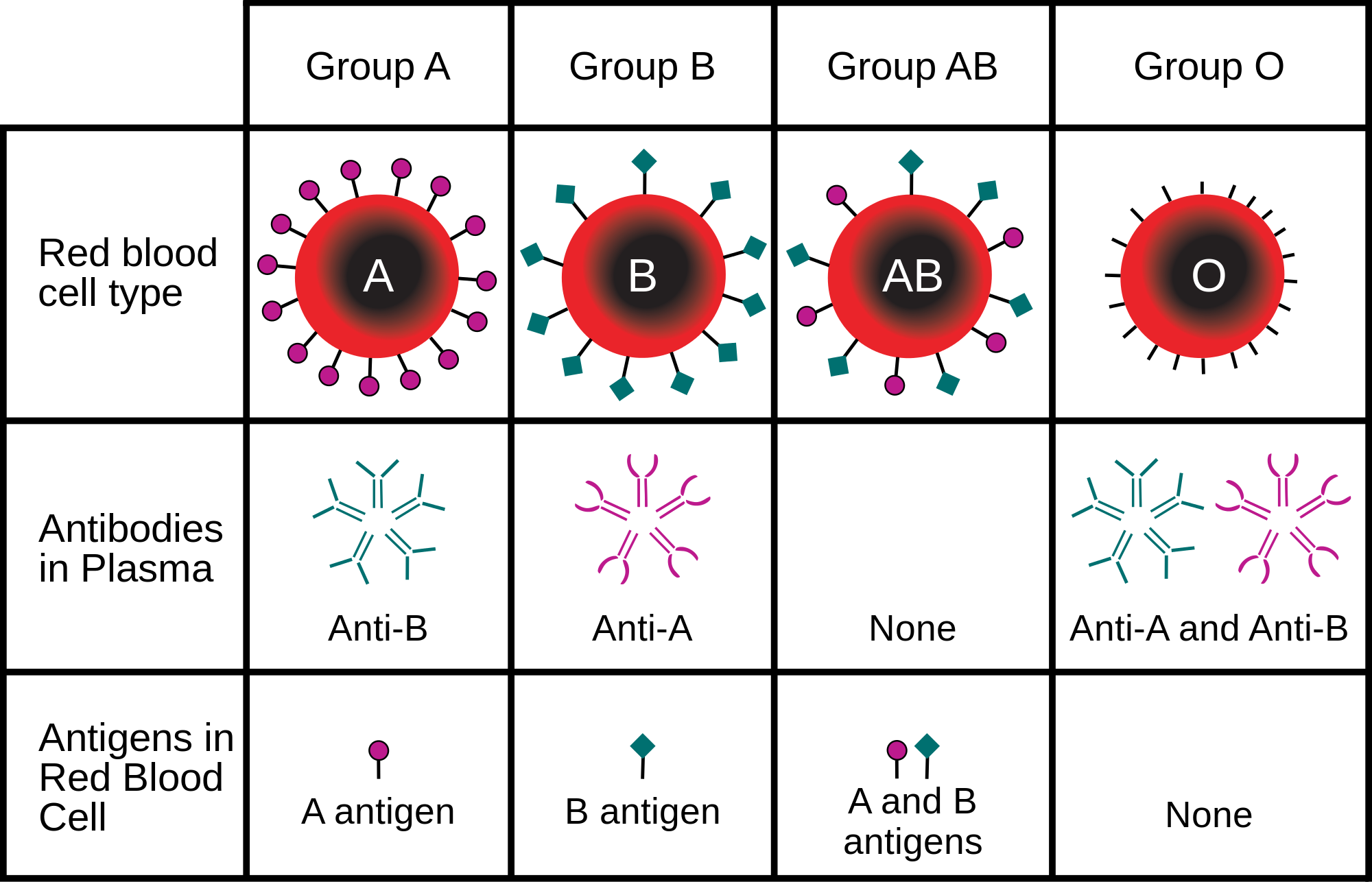Blood caries many chemicals, which have various functions. One group of chemicals is called antigens, which can stimulate the production of antibodies. Based on the presence or absence of blood antigens and antibodies, four groups A, B, AB and O are recognized in human body. Antigens are the proteins on the surface of red blood cells. Blood of one group contains antibodies in the plasma that reacts against the antigen on the cells of other groups.
Antigens: Antigens are foreign particles which when introduced into one’s body stimulates the immune system to produces specific chemical substance.
Antibody: Antibodies are specific chemical substances present in the blood serum released against antigens.
Different Blood Group System
- Blood group A contains A antigen in RBC (Red Blood Cells) and antibody B in plasma/serum.
- Blood group B contains B antigen in RBC and antibody A in plasma.
- Blood group AB contains A and B antigen in RBC and no antibody in plasma.
- Blood group O contains no antigens in RBC and antibodies A and B.

Depending upon the presence or absence of Rh-factor on the surface of RBC, the blood groups are divided into positive (+ve) and negative(-ve). Rh-factor is a type of antigen which is found on the surface of RBC. It is named as Rh-factor because it was discovered from the RBC of Rhesus Monkey. Visit this page to earn more about Rh-factor.
Thus, there are 8 blood groups altogether.
Inheritance of Blood Group
There are three alleles which determines the A,B,O blood groups in human. Here, both the alleles A and B are dominant. When A and B are present in a heterozygote condition, the blood groups is AB as these two alleles exist as co-dominants. Therefore, the letter I (isohaemoagglutinogen) is used as symbol of the genes. The O allele is recessive to both A and B. Three allelic genes IA , I B and IO control the inheritance of these groups in all human population. Out of these three alleles, only two alleles can be present in any human at a time. IA in homozygous condition (IA IA) produces antigen A. IB in homozygous condition (IB IB) produces antigen B but both the alleles in heterozygous condition (IAIB) produces antigen A and antigen B. IAIO produces antigen A and IBIO produces antigen B. But IO in homozygous condition produces neither antigen A nor antigen B.
Possible Genotype and Corresponding Blood Groups
| Blood Group | Genotype | Antigen | Antibody | % in human population |
|---|---|---|---|---|
|
A |
IAIA/IAIO |
A |
B |
42% |
|
B |
IBIB/IBIO |
B |
A |
9% |
|
AB |
IAIB |
A and B |
None |
3% |
|
O |
IOIO |
None |
A and B |
46% |
Blood Transfusion
Accurate knowledge of blood groups is important for blood transfusion. If type A blood is injected into the person with type B blood, the red blood cells will clump together. The reverse is also true. The clumping of blood is called agglutination. When agglutination occurs, the red blood corpuscles cannot carry oxygen and carbon dioxide. The result is fatal.
Hence the presence of antibody in plasma should be considered while transfusing blood. Blood group AB has no antibody in plasma , therefore people with blood group AB can receive blood from any type because no clumping will occur and AB blood group is called Universal Recipient . Clumping occurs if ‘Antigen’ A and ‘Antibody a’ and ‘Antigen B’ and ‘Antibody b’ get chance to react with each other. People with blood group O have no antigen in RBC , therefore the blood will not attracted by any antibodies and they can be transfused to any other groups ( A,B or AB) and hence called as Universal Donor.
People with blood group A can receive blood from O and A and can donate to AB and A. Similarly , people with blood group B can receive blood from O and B and can donate to B and AB. Likewise people with blood group AB can donate to only AB and can receive from ALL ( A, B, AB, and O) while in case of people with blood group O can donate to ALL(A, B, AB and O) and can receive only from O.
| Blood Groups | can give blood to | can get blood from |
|---|---|---|
| A | A,AB | O,A |
| B | B,AB | O,B |
| AB | AB | A,B,O,AB |
| O | A,B,AB,O | O |